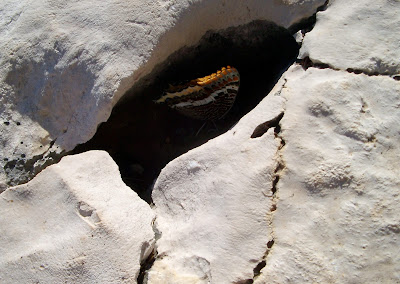As an epilogue to my last post, I thought that I should show you a photo of the only other time that I have seen a Two-tailed Pasha, on the serpentine island of Meneghello near Hvar in Croatia some 20 years ago. Unlike the hill-topper in Provence, it was swooping about on a beach and took cover in a fissure in the rocks - there is scarcely any sand in that part of the world. I managed to get the photo above but then it was off, and it did not come back.
I overlooked a discovery in France as well, a very familiar caterpillar which Penny saw scuttling across a forest path on our way back from inspecting an ancient 'rucher' or apiary, surrounded by warnings that bees can sting. I've already featured quite a few of these larva thanks to my granddaughter's excellence at spotting and breeding them - the Pale Tussock, or 'hop dog' known and often cursed by Kentish hop-pickers who reacted to the mild toxins on its hairs.
The beehives in hollowed out cork oak were fascinating. Known about for years in documents, they date back to the 17th century but were only rediscovered and restored in 2006. New hives were installed and now house more than 5000 Provence black bees. The forests of sweet chestnut, cork oak and arbutus - the last the larval foodplant of the Two-tailed Pasha as I mentioned in my last post - suit them well and their honey is most flavoursome.
Back here, I put out the trap last night in spite of the chilly weather - maybe warmed as well as illuminated by Guy Fawkes displays. I'm glad I did. My first December Moth of the year arrived in its smart fur coat, along with two Feathered Thorns. Here's the December Moth:
I moved it to our beech hedge for the Autumn colours, to remind me how early it has come - in terms of its name. Last year I did not record one until December had begun, although I was trapping very intermittently, And now here are the Feathered Thorns, one on the cowl and the other in an eggbox.
Finally, one a wall beside the light, I found this, below, which I think is a Satellite but I am studying further.
Oh, and a little non-moth too:










3 comments:
Nice finds, the beetle is one from the Timarcha genus. Not too sure about the millipede though.
Hi and thanks so much - very belatedly. I’ve been even slower-moving than usual over Christmas - too many lively grandchildren. It was a very exciting moment, seeing the Pasha. Just the feeling I used to get as a schoolboy with a net. All warmest and thanks again
Not sure why I’m anonymous 🙂
Post a Comment